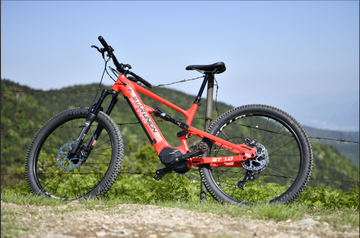How Long Do Hydraulic Disc Brakes Last? A Deep Dive into Durability and Aging
by YunaLi on Apr 21, 2025

Hydraulic disc brakes have become the go-to choice for modern bikes—from mountain and gravel bikes to high-end commuters. They deliver unmatched stopping power and smooth lever feel. But like any precision system, they age over time.
In this blog, we’ll explore how hydraulic disc brakes wear out, what causes them to degrade, and how to maintain them for long-lasting performance.
What Makes Up a Hydraulic Disc Brake?
A typical hydraulic brake system includes:
Brake Lever (Master Cylinder): Applies pressure to the fluid.
Brake Hose: Transfers hydraulic pressure to the caliper.
Brake Caliper: Pushes brake pads onto the rotor.
Brake Fluid (Mineral Oil or DOT Fluid): Acts as the pressure medium.
Each part plays a critical role—and each can degrade with time and use.

⏳ How Do Hydraulic Disc Brakes Age?
Here are the most common aging issues cyclists face:
1. Seals & Pistons Wear Out
Rubber seals inside the caliper and lever degrade from heat, moisture, and pressure cycles. Worn seals can cause leaks and spongy brake feel.
2. Brake Fluid Breakdown
DOT fluid absorbs water over time, reducing braking power and potentially causing internal corrosion.
Mineral oil is more stable, but still needs replacement every 1–2 years.
3. Pad & Rotor Wear
Brake pads naturally wear down with use. Worn pads not only reduce performance—they can also damage rotors if ignored too long.
4. Brake Hose Fatigue
Over time, hoses can crack, harden, or even burst, especially under heat or UV exposure.
�� Signs Your Brakes Are Aging
|
Time in Use |
Common Issues |
|
6–12 months |
Softer lever feel, pad wear begins |
|
1–2 years |
Fluid degradation, seals begin to age |
|
2–4 years |
Leaks, piston sticking, reduced power |
|
4+ years |
Major rebuild or full replacement needed |
How to Extend the Life of Your Brakes
Want to keep your brakes in top condition? Here’s what to do:
✅ Replace brake fluid every 12–18 months
✅ Inspect hoses for cracks or leaks
✅ Replace pads before they wear too thin
✅ Avoid storing your bike in direct sun or extreme temps
✅ Use OEM parts and fluids to avoid compatibility issues
These simple steps can double the lifespan of your hydraulic system.
�� Quick Tip: Mineral Oil vs. DOT Fluid
DOT brake fluid (used by SRAM, TRP): High performance but absorbs water—change more often.
Mineral oil (used by Shimano, Magura): Longer shelf life, less corrosive.
Check your brake type before doing any maintenance!

Is It Time to Replace or Rebuild?
If you’re experiencing:
Leaking calipers
Super spongy lever feel
Fading brake power on long descents
…then it’s probably time to bleed, rebuild, or replace your brake system. Many riders don’t realize their brakes have degraded until it affects performance—and safety.
Want Upgrades or Spare Parts?
Check out our Brake Accessories Collection for:
Replacement pads
Rotor upgrades
Brake fluid kits
Tools for home bleeding
Shop quality parts that match your riding style. Whether you ride trail, tarmac, or city streets—we’ve got you covered.
Final Thoughts
Hydraulic disc brakes are powerful, reliable, and smooth—but they’re not maintenance-free. Understanding how they age helps you ride safer and spend less in the long run. Stay proactive with your maintenance and your bike will reward you with years of confident stopping.



